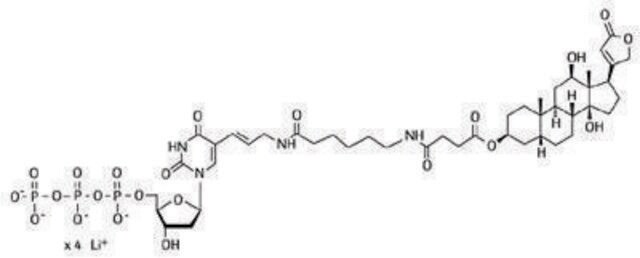추천 제품
사용
sufficient for 12 labeling reactions (10 ng to 3 μg per assay)
sufficient for 24 blots (blots of 100 cm2)
Quality Level
제조업체/상표
Roche
환경친화적 대안 제품 특성
Designing Safer Chemicals
Learn more about the Principles of Green Chemistry.
sustainability
Greener Alternative Product
환경친화적 대안 카테고리
저장 온도
−20°C
일반 설명
DIG-High Prime DNA Labeling and Detection Starter Kit II is a convenient kit for random-primed labeling of DNA templates with digoxigenin (DIG)-11- deoxyuridine triphosphate (dUTP), alkali-labile and chemiluminescent detection of the DIG-labeled hybrids. This kit was assembled with convenience in mind, offering ready-to-use CSPD supplied with a dripping device for easy application, ready-made blocking solution, and DIG Easy Hyb granules. The DIG-High Prime mixture includes stabilized Klenow enzyme, nucleotides, primers and reaction buffer, all in one convenient reagent.
We are committed to bringing you Greener Alternative Products, which adhere to one or more of The 12 Principles of Greener Chemistry. This product is designed as a safer chemical. The DIG System was established as a sensitive and cost-effective alternative to radioactivity for the labeling and detection of nucleic acids. There are many available publications that prove the versatility of the DIG System, so use of radio-labeling is no longer the only option for labeling of DNA for hybridization.
애플리케이션
DIG-High Prime DNA Labeling and Detection Starter Kit II has been used in a variety of hybridization techniques:
- in Southern blots
- in northern blots
- in dot blots
- in colony and plaque hybridizations
- for all types of filter hybridization
- for single-copy gene detection in total genomic DNA, even from organisms with high complexity, for example, human, barley, and wheat
포장
1 kit containing 7 components.
원리
The DIG High Prime DNA Labeling and Detection Starter Kit II uses digoxigenin (DIG), a steroid hapten, to label DNA probes for hybridization and subsequent chemiluminescence detection by enzyme immunoassay. The "random primed" DNA labeling method originally developed by Feinberg and Vogelstein is based on the hybridization of oligonucleotides of all possible sequences to the denatured DNA to be labeled. The input DNA serves solely as a template for the synthesis of labeled DNA, and is not degraded during the reaction, making it possible to label minimal amounts of DNA (10 ng) with this method.The complementary DNA strand is synthesized by Klenow polymerase using the 3′-OH termini of the random oligonucleotides as primers. Modified deoxyribonucleoside triphosphates, labeled with digoxigenin present in the reaction, are incorporated into the newly synthesized complementary DNA strand.
기타 정보
For life science research only. Not for use in diagnostic procedures.
키트 구성품 전용
제품 번호
설명
- DIG-High Prime 5x concentrated
- DIG-labeled Control DNA, pBR328 (linearized with Bam HI) 5 μg/ml
- DNA Dilution Buffer
- Anti-Digoxigenin-AP Conjugate antibody
- CSPD ready-to-use
- Blocking Solution 10x concentrated
- DIG Easy Hyb Granules
신호어
Warning
유해 및 위험 성명서
Hazard Classifications
Eye Irrit. 2 - Skin Irrit. 2
Storage Class Code
12 - Non Combustible Liquids
WGK
WGK 3
Flash Point (°F)
does not flash
Flash Point (°C)
does not flash
시험 성적서(COA)
제품의 로트/배치 번호를 입력하여 시험 성적서(COA)을 검색하십시오. 로트 및 배치 번호는 제품 라벨에 있는 ‘로트’ 또는 ‘배치’라는 용어 뒤에서 찾을 수 있습니다.
이미 열람한 고객
Jinxue Ruan et al.
Scientific reports, 5, 14253-14253 (2015-09-19)
Transgenic pigs play an important role in producing higher quality food in agriculture and improving human health when used as animal models for various human diseases in biomedicine. Production of transgenic pigs, however, is a lengthy and inefficient process that
Emmanuel Ogwok et al.
Journal of virological methods, 169(2), 296-304 (2010-08-10)
Cassava brown streak disease (CBSD), caused by two distinct species, Cassava brown streak Uganda virus (CBSUV) and Cassava brown streak virus (CBSV), is a major constraint to cassava (Manihot esculenta Crantz) production in Africa. Absence of infectious clones of CBSUV
Rajiv R Mohan et al.
PloS one, 6(4), e18771-e18771 (2011-05-03)
Untargeted and uncontrolled gene delivery is a major cause of gene therapy failure. This study aimed to define efficient and safe tissue-selective targeted gene therapy approaches for delivering genes into keratocytes of the cornea in vivo using a normal or
Yu Du et al.
Tetrahedron, 67(35), 6568-6575 (2011-08-27)
The apoptolidins are 20/21-membered macrolides produced by Nocardiopsis sp. FU40. Several members of this family are potent and remarkably selective inducers of apoptosis in cancer cell lines, likely via a distinct mitochondria associated target. To investigate the biosynthesis of this
Yanrong Liu et al.
Plant & cell physiology, 58(12), 2226-2240 (2017-10-27)
The microRNA393 (miR393) family is one of the conserved miRNA families in the plant kingdom. MiR393 was reported to regulate rice tillering and abiotic stress resistance positively through an auxin signaling pathway. However, little is known about the function of
문서
Digoxigenin (DIG) labeling methods and kits for DNA and RNA DIG probes, random primed DNA labeling, nick translation labeling, 5’ and 3’ oligonucleotide end-labeling.
자사의 과학자팀은 생명 과학, 재료 과학, 화학 합성, 크로마토그래피, 분석 및 기타 많은 영역을 포함한 모든 과학 분야에 경험이 있습니다..
고객지원팀으로 연락바랍니다.







